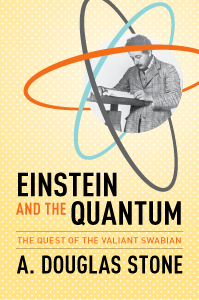Séminaire Exceptionnel le 13 Juin à l’ESPCI Paris. Par A. Douglas Stone, de l’Université de Yale. Le chercheur a récemment publié un livre intitulé "Einstein and the Quantum" qui s’appuie en partie sur des correspondances historiques conservées par le fonds documentaire de l’école, et qui seront exceptionnellement exposées pour l’occasion. Catherine Kounélis, Responsable de la Bibliothèque et du fonds historique de l’école présentera ces différents documents, incluant 2 lettres d’Albert Einstein, un document dans lequel Paul Langevin propose Albert Einstein pour le prix Nobel, et la thèse de Louis de Broglie (document rare).
Le séminaire, en anglais, aura lieu en Amphithéâtre Urbain, à partir de 11H.

Abstract :
Einstein is well known for his rejection of quantum mechanics in the form it emerged from the work of Heisenberg, Born and Schrodinger in 1926. Much less appreciated are the many seminal contributions he made to quantum theory prior to his final scientific verdict : that the theory was at best incomplete. In this talk I present an overview of Einstein’s many conceptual breakthroughs and place them in historical context. I argue that Einstein, much more than Planck, introduced the concept of quantization of energy in atomic mechanics. Einstein proposed the photon, the first force-carrying particle discovered for a fundamental interaction, and put forward the notion of wave-particle duality, based on sound statistical arguments 14 years before De Broglie’s work. He was the first to recognize the intrinsic randomness in atomic processes, and introduced the notion of transition probabilities, embodied in the A and B coefficients for atomic emission and absorption. He also preceded Born in suggesting the interpretation of wave fields as probability densities for particles, photons, in the case of the electromagnetic field. Finally, stimulated by Bose, he introduced the notion of indistinguishable particles in the quantum sense and derived the condensed phase of bosons, which is one of the fundamental states of matter at low temperatures. His work on quantum statistics in turn directly stimulated Schrodinger towards his discovery of the wave equation of quantum mechanics. It was only due to his rejection of the final theory that he is not generally recognized as the most central figure in this historic achievement of human civilization.